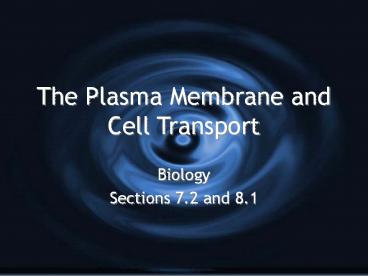The Plasma Membrane and Cell Transport - PowerPoint PPT Presentation
Title:
The Plasma Membrane and Cell Transport
Description:
The Plasma Membrane and Cell Transport Biology Sections 7.2 and 8.1 Plasma Membrane Plasma membrane - flexible boundary between a cell and its environment. – PowerPoint PPT presentation
Number of Views:147
Avg rating:3.0/5.0
Title: The Plasma Membrane and Cell Transport
1
The Plasma Membrane and Cell Transport
- Biology
- Sections 7.2 and 8.1
2
Plasma Membrane
- Plasma membrane - flexible boundary between a
cell and its environment.
Outside Cell
Inside Cell
3
What is the nickname of the Plasma Membrane?
- The Gate Keeper
Because it maintains homeostasis by controlling
what enters and leaves the cell.
4
What does selectively permeable mean?
- Membrane allows some molecules to pass while
keeping others out. - Kind of like the screen on your window.
5
Structure of the Plasma Membrane.
- Made of phospholipids like the one below
6
Phospholipid
- Phospholipid is made of glycerol backbone, two
fatty acid tails and a phosphate group.
Polar head (includes phosphate group)
Glycerol Backbone
Nonpolar tails (fatty acids)
7
Phosholipid Bilayer
- There are two layers of phospholipids back to
back, making the plasma membrane a phospholipid
bilayer.
8
Model of the Plasma Membrane
- Fluid Mosaic Model
9
What can be found in the Plasma Membrane
- Proteins (Transport Proteins)
- Cholesterol - for stabilizing the phospholipids.
- Carbohydrates - identify chemical signals.
10
Transport Proteins
11
Cholesterol
12
Carbohydrates
Carbohydrates
13
- Plasma Membrane Activity
- Color/draw the plasma membrane.
14
Transport Across the Plasma Membrane
- 2 Main Types
- Passive Transport -
- Moves things with their concentration gradient.
- No energy needed!
- Active Transport -
- Moves things against their concentration
gradient. - Requires energy!
15
What is a concentration gradient?
16
Passive TransportMoves things from high to low
concentration.
- Diffusion - simple movement from high to low
concentration. No ENERGY required! - Osmosis - diffusion of water across a selectively
permeable membrane. (No ENERGY required!) - Facilitated Diffusion - passive transport using a
channel or carrier protein. (still does not
require energy)
17
Diffusion
18
Osmosis
19
Osmotic Pressure
20
Turgor Pressure - pressure of the water in a full
vacuole of a plant cell against the cell wall.
21
Active Transport
- Protein pump used to move particles from low to
high concentration.
22
Na K
23
Transport of Large Particles
- Endocytosis - process by which a cell surrounds
and takes in material. (Requires ENERGY) - Exocytosis - the explusion or secretion of a
material from a cell. (Requires ENERGY)
24
Endocytosis
25
Exocytosis































